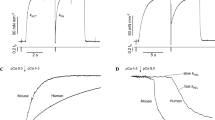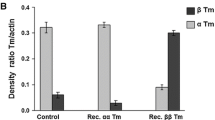Abstract
Secophalloidin (SPH) is known to cause in cardiac myofibrils force without Ca2+ (half-maximal effect ~2 mM) followed by irreversible loss of Ca2+-activated force. At maximal Ca2+ activation, SPH increases force (half-maximal effect < 0.1 mM). We found that SPH at low concentration (0.5 mM) did not cause either force activation or force loss at pCa 8.7, but both of these effects did occur when force was activated by Ca2+. The force loss was prevented when SPH was applied during rigor or in the presence of 2,3-butanedione monoxime (85 mM). Furthermore, studying muscle in which the force was previously reduced by SPH (up to 50%) did not reveal significant changes in Ca2+ sensitivity and cooperativity of Ca2+ activation or qualitative alterations in SPH-induced changes in Ca2+-activated contraction. Data suggest that the force loss is mediated by cycling cross-bridges, and might reflect a reduction in force generated by individual cross-bridges.




Similar content being viewed by others
Abbreviations
- AM:
-
Actomyosin
- AMP-PNP:
-
Adenosine 5′-(β,γ-imido)triphosphate
- A2P5 :
-
P1,P5-di(adenosine-5′) pentaphosphate
- BDM:
-
2,3-Butanedione monoxime
- TnC:
-
Troponin C
- Tm:
-
Tropomyosin
- SPH:
-
Secophalloidin
References
Baudenbacher F, Schober T, Pinto JR, Sidorov VY, Hilliard F, Solaro RJ, Potter JD, Knollmann BC (2008) Myofilament Ca2+ sensitization causes susceptibility to cardiac arrhythmia in mice. J Clin Invest 118:3893–3903
Bremel RD, Weber A (1972) Cooperation within actin filament in vertebrate skeletal muscle. Nat New Biol 238:97–101
Bukatina AE, Sieck GC (2003a) Secophalloidin as a novel activator of skinned cardiac muscle. Biochem Biophys Res Commun 301:646–649
Bukatina AE, Sieck GS (2003b) Phallotoxins as an instrument for studying the intramyofibrillar regulation of muscle contraction. [Russian] Biofizika 48:1086–1093 (English version: Bukatina AE, Sieck GC (2003b) Myofibrillar regulation of contraction as revealed with phallotoxins. Biophysics 48:1003–1010)
Bukatina AE, Son’kin BIa, Alievskaia LL (1984) Interactions of vanadate with the contractile system of the rabbit psoas muscle in active, relaxed and rigor states. [Russian] Biofizika. 29:280–283 [English version: Bukatina AE, Son’kin BY, Alievskaia LL (1984) Interactions of vanadate with the contractile system of the rabbit psoas muscle in active, relaxed and rigor states. Biophysics 29:303–313]
Bukatina AE, Kirkpatrick RD, Campbell KB (1998) Dethiophalloidin increases Ca2+ responsiveness of skinned cardiac muscle. J Muscle Res Cell Motil 19:515–523
Bukatina AE, Kirkpatrick RD, Campbell KB (2000) Secophalloidin and phalloidin-(S)-sulfoxide as contraction modifiers for comparative study of skeletal and cardiac muscles. Tsitologiia 42:37–41
Bukatina AE, Theodore LJ, Campbell KB, Sieck GC (2002) Calcium-independent activation of skinned cardiac muscle by secophalloidin. FEBS Lett 519:201–204
Bukatina AE, Sieck GC, Belohlavek M (2006) Phallotoxins as a novel tool for muscle research. In: Pandalai SG (ed) Recent research development in biophysics, vol 5. Transworld Research Network, Kerala, pp 257–267
Dou Y, Arlock P, Arner A (2007) Blebbistatin specifically inhibits actin-myosin interaction in mouse cardiac muscle. Am J Physiol Cell Physiol 293:C1148–C1153
Fabiato A (1981) Myoplasmic free calcium concentration reached during the twitch of an intact isolated cardiac cell and during calcium-induced release of calcium from the sarcoplasmic reticulum of a skinned cardiac cell from the adult rat or rabbit ventricle. J Gen Physiol 78:457–497
Fitzsimons DP, Patel JR, Moss RL (2001) Cross-bridge interaction kinetics in rat myocardium are accelerated by strong binding of myosin to the thin filament. J Physiol 530:263–272
Fuchs F, Martyn D (2005) Length-dependent Ca2+ activation in cardiac muscle: some remaining questions. J Muscle Res Cell Motil 26:199–212
Gillis TE, Martyn DA, Rivera AJ, Regnier M (2007) Investigation of thin filament near-neighbour regulatory unit interactions during force development in skinned cardiac and skeletal muscle. J Physiol 580:561–576
Gordon AM, Homsher E, Regnier M (2000) Regulation of contraction in striated muscle. Physiol Rev 80:853–924
Gordon AM, Rivera AJ, Wang CK, Regnier M (2003) Cooperative activation of skeletal and cardiac muscle. Adv Exp Med Biol 538:371–378
Herrmann C, Wray J, Travers F, Barman T (1992) Effect of 2,3-butanedione monoxime on myosin and myofibrillar ATPases. An example of an uncompetitive inhibitor. Biochemistry 31:12227–12232
Hinken A, Solaro R (2007) A dominant role of cardiac molecular motors in the intrinsic regulation of ventricular ejection and relaxation. Physiology 22:73–80
Horiuti K, Yagi N, Takemori S, Yamaguchi M (2003) An x-ray diffraction study on the ADP-induced conformational change in skeletal muscle myosin. J Biochem 133:207–210
Kentish JC (1986) The effects of inorganic phosphate and creatine phosphate on force production in skinned muscles from rat ventricle. J Physiol 370:585–604
Kovacs M, Toth J, Hetenyi C, Malnasi-Czismadia A, Sellers J (2004) Mechanism of blebbistatin inhibition of myosin II. J Biol Chem 279:35557–35563
Marston SB, Rodger CD, Tregear RT (1976) Changes in muscle crossbridges when beta, gamma-imido-ATP binds to myosin. J Mol Biol 104:263–276
Metzger JM (1995) Myosin binding-induced cooperative activation of the thin filament in cardiac myocytes and skeletal muscle fibers. Biophys J 68:1430–1442
Moss RL, Razumova M, Fitzsimons DP (2004) Myosin crossbridge activation of cardiac thin filaments: implications for myocardial function in health and disease. Circ Res 94:1290–1300
Perrin DD, Sayce LG (1967) Computer calculation of equilibrium concentrations in mixtures of metal ions and complexing species. Talanta 14:833–842
Pettit LD, Siddiqui KF (1976) The proton and metal complexes of adenyl-5’-yl imidodiphosphate. Biochem J 159:169–171
Regnier M, Morris C, Homsher E (1995) Regulation of the cross-bridge transition from a weakly to strongly bound state in skinned rabbit muscle fibers. Am J Physiol 269:C1532–C1539
Straight AF, Cheung A, Limouze J, Chen I, Westwood NJ, Sellers JR, Mitchison TJ (2003) Dissecting temporal and spatial control of cytokinesis with a myosin II Inhibitor. Science 299:1743–1747
Swartz DR, Moss RL (1992) Influence of a strong-binding myosin analogue on calcium-sensitive mechanical properties of skinned skeletal muscle fibers. J Biol Chem 267:20497–20506
Wieland T (1986) Peptides of poisonous amanita mushrooms. Springer, New York
Acknowledgments
The authors are thankful to Dr. Eileen McMahon for critical reading of the manuscript and constructive comments. This study was supported in parts by NIH grants HL34817, and HL68555, and by a grant from GE Healthcare.
Author information
Authors and Affiliations
Corresponding author
Rights and permissions
About this article
Cite this article
Bukatina, A.E., Sieck, G.C., Campbell, K.B. et al. Characterization of secophalloidin-induced force loss in cardiac myofibrils. J Muscle Res Cell Motil 30, 209–216 (2009). https://doi.org/10.1007/s10974-009-9188-7
Received:
Accepted:
Published:
Issue Date:
DOI: https://doi.org/10.1007/s10974-009-9188-7




